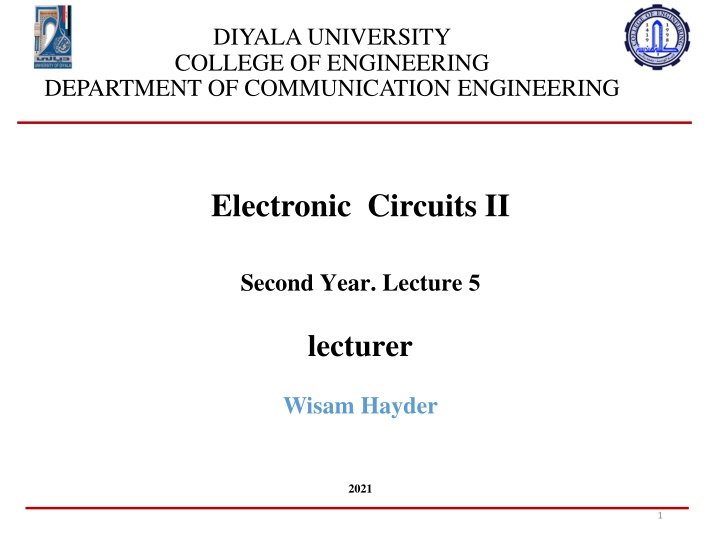
Direct-Coupled Amplifier Circuits for Signal Amplification
Explore the principles and applications of direct-coupled amplifier circuits in electronic engineering. Understand the design simplicity and signal amplification process using complementary transistors. Discover how these circuits eliminate the need for coupling devices to enhance weak signals effectively.
Uploaded on | 3 Views
Download Presentation

Please find below an Image/Link to download the presentation.
The content on the website is provided AS IS for your information and personal use only. It may not be sold, licensed, or shared on other websites without obtaining consent from the author. If you encounter any issues during the download, it is possible that the publisher has removed the file from their server.
You are allowed to download the files provided on this website for personal or commercial use, subject to the condition that they are used lawfully. All files are the property of their respective owners.
The content on the website is provided AS IS for your information and personal use only. It may not be sold, licensed, or shared on other websites without obtaining consent from the author.
E N D
Presentation Transcript
DIYALA UNIVERSITY COLLEGE OF ENGINEERING DEPARTMENT OF COMMUNICATION ENGINEERING Electronic Circuits II Second Year. Lecture 5 lecturer Wisam Hayder 2021 1
6. Transformer-Coupled Amplifier Homework Ex 1. Determine the necessary transformer turn ratio for transferring maximum power to a 16 load from a source that has an output impedance of 10 k . Also calculate the voltage across the external load if the terminal voltage of the source is 10V r.m.s. Ex 2. The output resistance of the transistor shown in Fig. 1 is 3k . The primary of the transformer has a d.c. resistance of 300 and the load connected across secondary is 3 . Calculate the turn ratio of the transformer for transferring maximum power to the load. 2
6. Transformer-Coupled Amplifier Fig.1 3
7. Direct-Coupled Amplifier There are many applications in which extremely low frequency (<10 Hz) signals are to be amplified e.g. amplifying photo- electric current, thermo-couple current etc. The coupling devices such as capacitors and transformers cannot be used because the electrical sizes of these components become very large at extremely low frequencies. 4
7. Direct-Coupled Amplifier Under such situations, one stage is directly connected to the next stage without any intervening coupling device. This type of coupling is known as direct coupling. Circuit details. Fig. 11.19 shows the circuit of a three-stage direct- coupled amplifier. It uses complementary transistors. 5
7. Direct-Coupled Amplifier Thus, the first stage uses npn transistor, the second stage uses pnp transistor and so on. This arrangement makes the design very simple. The output from the collector of first transistor T1 is fed to the input of the second transistor T2 and so on. 6
7. Direct-Coupled Amplifier The weak signal is applied to the input of first transistor T1. Due to transistor action, an amplified output is obtained across the collector load RC of transistor T1. This voltage drives the base of the second transistor and amplified output is obtained across its collector load. In this way, direct coupled amplifier raises the strength of weak signal. 8
7. Direct-Coupled Amplifier Advantages (i) The circuit arrangement is simple because of minimum use of resistors. (ii) The circuit has low cost because of the absence of expensive coupling devices. Disadvantages (i) It cannot be used for amplifying high frequencies. (ii) The operating point is shifted due to temperature variations. 9
7. Direct-Coupled Amplifier Fig. 2 shows a direct coupled two-stage amplifier. Determine (i) d.c. voltages for both stages (ii) voltage gain of each stage and overall voltage gain. Fig. 2 10
7. Direct-Coupled Amplifier Comparison of Different Types of Coupling 14
Transistor Tuned Amplifiers TunedAmplifiers Amplifiers which amplify a specific frequency or narrow band of frequencies are called tuned amplifiers. Tuned amplifiers are mostly used for the amplification of high or radio frequencies. It is because radio frequencies are generally single and the tuned circuit permits their selection and efficient amplification. 15
Transistor Tuned Amplifiers However, such amplifiers are not suitable for the amplification of audio frequencies as they are mixture of frequencies from 20 Hz to 20 kHz and not single. Tuned amplifiers are widely used in radio and television circuits where they are called upon to handle radio frequencies. 16
Transistor Tuned Amplifiers Fig. 15.1 shows the circuit of a simple transistor tuned amplifier. Here, instead of load resistor, we have a parallel tuned circuit in the collector. The impedance of this tuned circuit strongly depends upon frequency. It offers a very high impedance at resonant frequency and very small impedance at all other frequencies. 17
Transistor Tuned Amplifiers If the signal has the same frequency as the resonant frequency of LC circuit, large amplification will result due to high impedance of LC circuit at this frequency. When signals of many frequencies are present at the input of tuned amplifier, it will select and strongly amplify the signals of resonant frequency while rejecting all others. 19
Transistor Tuned Amplifiers Therefore, such amplifiers are very useful in radio receivers to select the signal from one particular broadcasting station when signals of many other frequencies are present at the receiving aerial. 20 20
